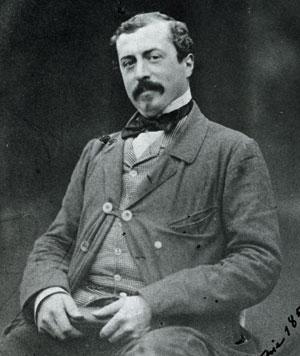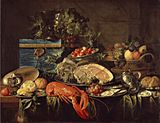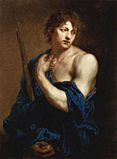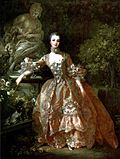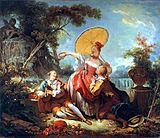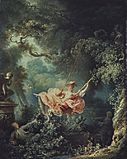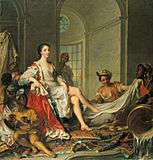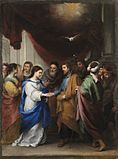Wallace Collection facts for kids
 |
|
| Lua error in Module:Location_map at line 420: attempt to index field 'wikibase' (a nil value). | |
| Established | 1897 |
|---|---|
| Location | Manchester Square London, WC1 United Kingdom |
| Collection size | approx. 5,500 objects |
| Visitors | 419,020 (2016) |
| Public transit access | |
| Area | 30 galleries |
The Wallace Collection is a museum in London occupying Hertford House in Manchester Square, the former townhouse of the Seymour family, Marquesses of Hertford. It is named after Sir Richard Wallace, who built the extensive collection, along with the Marquesses of Hertford, in the 18th and 19th centuries. The collection features fine and decorative arts from the 15th to the 19th centuries with important holdings of French 18th-century paintings, furniture, arms and armour, porcelain and Old Master paintings arranged into 25 galleries. It is open to the public and entry is free.
It was established in 1897 from the private collection mainly created by Richard Seymour-Conway, 4th Marquess of Hertford (1800–1870), who left both it and the house to his illegitimate son Sir Richard Wallace (1818–1890), whose widow Julie Amelie Charlotte Castelnau bequeathed the entire collection to the nation. The collection opened to permanent public view in 1900 in Hertford House, and remains there to this day. A condition of the bequest was that no object should ever leave the collection, even for loan exhibitions. In September 2019, the Board of Trustees announced that they had successfully obtained an Order from the Charity Commission for England & Wales which allowed them to enter into temporary loan agreements for the first time.
The United Kingdom is particularly rich in the works of the ancien régime, purchased by wealthy families during the revolutionary sales, held in France after the end of the French Revolution. The triumvirate of The Wallace Collection, Waddesdon Manor and the Royal Collection, all three located in the United Kingdom, forms arguably the largest, most important and extant collection of French 18th-century decorative arts in the world, rivalled only by the triumvirate of the Musée du Louvre, Château de Versailles and Mobilier National in France. The Wallace Collection is a non-departmental public body and the current director is Xavier Bray.
History
The Wallace Collection is a museum which displays works of art collected in the 18th and 19th centuries by five generations of a British aristocratic family – the first four Marquesses of Hertford and Sir Richard Wallace, the illegitimate son of the 4th Marquess. In the 19th century, the Marquesses of Hertford were one of the wealthiest families in Europe. They owned large properties in England, Wales and Ireland, and increased their wealth through successful marriages. Politically of lesser importance, the 3rd and 4th Marquess and Sir Richard Wallace became leading art collectors of their time.
The Wallace Collection, comprising about 5,500 works of art, was bequeathed to the British nation by Lady Wallace in 1897. The state then decided to buy Hertford House to display the collection and it was opened as a museum in 1900. As a museum the Wallace Collection's main strength is 18th-century French art: paintings, furniture, porcelain, sculpture and gold snuffboxes of the finest quality and often with illustrious provenances from great collections. Complementing the 18th-century French works are masterpieces of 16th- to 19th-century painting by some of the greatest names of European art, such as Titian, Van Dyck, Rembrandt, Hals, Velázquez, Gainsborough and Delacroix, the finest collection of princely arms and armour in Britain and superb medieval and Renaissance objects including Limoges enamels, maiolica, glass and bronzes. Paintings, furniture and porcelain are displayed together to recreate the atmosphere of the grand private collections of the 19th century.
Building
The 16th- and 17th-century Hertford House was the townhouse of Edward Seymour, 1st Earl of Hertford (1539–1621) and was in a different location: Cannon Row in Westminster. His father Edward Seymour, 1st Duke of Somerset (executed 1552), brother of Queen Jane Seymour, had started building the palatial Somerset House on the Strand as his townhouse, but did not live to see its completion. The present House in Manchester Square was the townhouse of a later branch of the family. Hertford House was where Sir Richard and Lady Wallace lived – a London townhouse that was first built in the 18th century and afterwards continually changed and refurbished. It was one of the numerous properties that belonged to the family, although prior to Sir Richard and Lady Wallace taking residence in 1870, it was only lived in briefly by the family in the late 18th century. In its history the house served as both the French and Spanish Embassy. In 2000, the inner courtyard was given a glass roof and a restaurant was opened named "Cafe Bagatelle" after the Château de Bagatelle in Paris purchased in 1835 by Francis Seymour-Conway, 3rd Marquess of Hertford. The museum display does not aim to reconstruct the state of the house when Sir Richard and Lady Wallace lived here.
Interior
Ground Floor
Hall
The Entrance Hall contains marble busts of the three principal Founders of the Wallace Collection: Richard Seymour-Conway, 4th Marquess of Hertford (1800–70), his son, Sir Richard Wallace (1818–90) and in the lobby, Lady Wallace, who bequeathed the contents of Hertford House to the British Nation on her death in 1897. The room has retained the aspect it had in Sir Richard Wallace's day more than any other room in the building.
Front State Room
This room reveals the opulence of the London town house in the 1870s and sets the scene for visitors to the Wallace Collection. The State Rooms were the grandest rooms in the house, in which the most important visitors were received. When it was the home of Sir Richard and Lady Wallace, visitors to Hertford House first entered the Front State Room, then, as now, hung with portraits. Some of the modern furniture seen in the room in 1890 is no longer in the collection, but the mounted porcelain displayed on the cabinets and the chandelier, made by Jean-Jacques Caffiéri, have been returned to the room.
-
Sèvres - Three rare pieces from the celebrated collection of Catherine the Great of Russia, now held in the Hermitage Museum
Back State Room
Displays: The Rococo at the time of Louis XV and Madame de Pompadour
The Back State Room is today dedicated to the patronage of King Louis XV (1715–74) and his mistress, Madame de Pompadour. It displays some of the prominent examples in the Wallace Collection of art in the rococo style, which flourished under their auspices. 'Rococo' derives from the French word 'rocaille', which means loose stones on rocky ground. This exuberant, animated style explores asymmetrical natural shapes with fountain imagery, foliage and flowers, swirling scrolls and sea animals. Sir Richard Wallace used the Back State Room to entertain guests at Hertford House. During his lifetime it had wooden boiserie panelling on the wall; the great chandelier, by Jacques Caffiéri, dating from 1751, remains in the room.
-
Antoine Gaudreau – This highly-important commode, with gilt-bronze mounts by Jacques Caffieri, was delivered in April 1739 for King Louis XV's Bedchamber at the Palace of Versailles
Dining Room
Displays: Eighteenth-century still lifes and portraits
The room contains masterworks of French 18th-century portraiture by Nattier and Houdon and two oil sketches by Jean François de Troy, for decoration of Louis XV's dining room in Fontainebleau, shown to the king for approval.
Billiard Room
Displays: The Decorative Arts under Louis XIV
Breakfast Room
Displays: Visitor Reception and Cloakroom
This room was formerly Sir Richard and Lady Wallace's breakfast room. As this photograph from c. 1890 shows, it contained a large cabinet filled with Sèvres porcelain dinner wares, probably more for use than decoration, and sixteen Dutch pictures. The French chimneypiece in this room was made in the mid-18th century and installed in this room when the house was modified for Sir Richard and Lady Wallace.
Housekeeper's Room
Displays: Wallace Collection Shop
This room was occupied during Sir Richard and Lady Wallace's lifetime by the family's housekeeper. Lady Wallace's housekeeper was Mrs Jane Buckley, a Londoner by birth. There were over thirty servants, including housemaids, kitchen maids, a lady's maid, a butler, footmen, a valet, coachmen, a groom and stable lads.
Oriental Armoury
Displays: East European, Turkish and Indo-Persian Arms, Armour and Works of Arts
The Oriental arms and armour in the Wallace Collection was largely collected by the 4th Marquess of Hertford in the 1860s, the last decade of his life. Like many of his contemporaries, Sir Richard Wallace used this material to bring Oriental exoticism, as it was then considered, into his fashionable London house. The Oriental Armoury was displayed on the first floor of Hertford House. Trophies of arms and armour from India, the Middle East, the lands of the old Ottoman Empire, and the Far East, patterned the walls of the Oriental Armoury, whilst the ceiling was decorated with a pattern of gold stars on a deep blue background.
European Armoury I
Displays: Medieval and Renaissance Arms and Armour (tenth to sixteenth centuries)
Sir Richard Wallace acquired most of his European armour in 1871, when he bought the collections of the comte Alfred Emilien de Nieuwekerke, Minister of Fine Arts to Napoleon III and director of the Louvre, as well as the finest parts of the collection of Sir Samuel Rush Meyrick, a pioneering collector and scholar of arms and armour. The arms and armour collections are today recognised as among the finest in the world. During Sir Richard Wallace's lifetime, this room formed part of the stables with the grooms' bedrooms on a mezzanine floor. Sir Richard's European arms and armour was displayed in one large gallery, today's West Gallery III, on the first floor, directly above European Armoury I.
European Armoury II
Displays: Renaissance Arms and Armour (fifteenth to seventeenth centuries)
The Wallace Collection contains some of the most spectacular Renaissance arms and armour in Britain. All of the richest and most powerful noblemen of the 15th, 16th and 17th centuries commissioned beautifully decorated weapons and armour, not just for war, but also for use in the awe-inspiring jousts, tournaments and festivals of the time. Fine arms and armour were considered works of art as much as warlike equipment. Displayed in this gallery are some of the finest examples of the armourer's art, exquisite sculptures richly embellished with gold and silver. This space was formerly part of Sir Richard Wallace's stables.
European Armoury III
Displays: Later Arms and Armour (sixteenth to nineteenth centuries)
The array of sporting guns, rifles and pistols in this room includes a large number of extravagantly decorated 16th- and early-17th-century wheel-lock firearms, together with an impressive group of magnificent civilian flint-lock guns of the Napoleonic era. Several of the weapons here were made for European rulers, including Louis XIII and Louis XIV of France and Tsar Nicholas I of Russia. It is a major collection of early firearms in the United Kingdom. This space was formerly part of Sir Richard Wallace's coach house and stable yard.
Sixteenth-Century Gallery
Displays: The Collector's Cabinet
The Sixteenth-Century Gallery houses works of art from the Medieval and Renaissance periods and a group of important Renaissance paintings. This part of the Wallace Collection was mainly assembled by Sir Richard who, like many 19th-century collectors, was fascinated by the art and history of Europe during the Middle Ages and Renaissance. The Sixteenth-Century Gallery comprised two smaller rooms during Sir Richard and Lady Wallace's lifetime. The contemporary photograph shows how one room was arranged by Sir Richard as a cabinet of curiosities, with paintings and maiolica densely hung on the walls and smaller works of art kept in cases or inside Renaissance cabinets. The other room, known as the Canaletto Room, was used to display the collection of paintings by Canaletto.
Smoking Room
Displays: Medieval and Renaissance Works of Art
The Smoking Room exhibits paintings and works of art from the Medieval and Renaissance periods, including the greater part of Sir Richard Wallace's collection of Italian Renaissance maiolica. Sir Richard Wallace would have invited his male guests to the Smoking Room after dinner, to discuss affairs of the day over an enjoyable pipe or cigar. The room had oriental interiors, with walls lined with Turkish-style tiles made by the Minton factory in Stoke-on-Trent, the floor laid with a patterned mosaic. A small section of this interior survives in the alcove at the north end of the room. This was not only a highly fashionable look for a late Victorian smoking room but also practical, ensuring the smell of smoke did not linger in any fabric furnishings.
Upper Floor
Landing
The Landing serves as the main orientation point on the first floor. It is hung with mythological and pastoral paintings by Boucher and is also perhaps the best place to admire the wrought iron work of the staircase balustrade, made in 1719 for the Royal bank in Paris. Hertford House was built in 1776–78 for the 4th Duke of Manchester. After a brief spell as the Spanish Embassy, it was bought by the 2nd Marquess of Hertford in 1797. He added the conservatory, in place of a Venetian window on the Landing and two first-floor rooms on each wing.
Lower Ground Floor
Porphyry Court
The Porphyry Court was little more than a rather dismal back yard until 2000, when it was transformed by being doubled in size and provided with a dramatic pair of flights of stairs.
Collections
The Collection numbers nearly 5,500 objects encompassing a superb range of fine and decorative arts from the 15th to the 19th centuries. The collection is best known for its quality and breadth of magnificent 18th-century French paintings, Sèvres porcelain and French furniture but also displays many other treasures, such as the finest collection of princely arms and armour in Britain featuring both European and Oriental objects, as well as choice and opulent displays of gold boxes, miniatures, sculpture and medieval and Renaissance works of art such as maiolica, glass, bronzes and Limoges enamels. Every area of the Collection contains works of art of the very highest quality.
The works of art in the Collection comprise:
-
- Paintings, watercolours and drawings 775
- Furniture 528
- Ceramics 510
- European and Oriental arms and armour 2,370
- Sculpture 466
- Miniatures 334
- Medieval and Renaissance works of art 363
- Goldsmiths' work 120
Departments
The Wallace Collection is split into six curatorial departments: Pictures and Miniatures; Ceramics and Glass; Sculpture and Works of Art; Arms and Armour; Sèvres porcelain; and Gold Boxes and Furniture.
Pictures and miniatures
The Wallace Collection's Old Master paintings are some of the most prominent in the world, and date from the 14th to the mid-19th centuries. The highlights include Dutch and Flemish paintings of the 17th century, 18th- and 19th-century French paintings, and works by English, Italian and Spanish artists. Strengths of the collection include 5 Rembrandts (and school), 9 Rubens's, 4 Van Dycks, 8 Canalettos, 9 Guardis, 19 François Bouchers, Fragonard, 9 Murillos, 9 Teniers, 2 Titians, Poussin, 3 Velázquezs and 8 Watteaus. The inventory of pictures, watercolours and drawings comprises all the major European schools.
Paintings, drawing and watercolours in the collection
- British, German, Spanish, and Italian – 151 paintings, 60 drawings
- French (19th century) – 134 paintings, 57 watercolours
- French (before 1815) – 144 paintings, 8 drawings and watercolours
- Dutch – 173 paintings, 2 drawings
- Flemish – 8 paintings
Dutch School:
|
|
-
Aelbert Cuyp - The Avenue at Meerdervoort, 1650–1652
-
Frans Hals – The Laughing Cavalier, 1624
-
Nicolaes Maes - The Listening Housewife, 1656
-
Rembrandt – The Artist's Son Titus, c. 1657
-
Rembrandt - The Good Samaritan, 1630
English School
-
- Thomas Gainsborough – 2 paintings
- John Hoppner – 1 painting
- Sir Edwin Landseer – 4 paintings
- Thomas Lawrence – 5 paintings
- Joshua Reynolds – 12 paintings
- J. M. W. Turner – 4 paintings
-
Thomas Gainsborough – Mrs Mary Robinson (Perdita), c. 1781
Flemish School
-
- Hans Memling – 1 painting
- Pieter Pourbus – 1 painting
- Pourbus the Elder, Frans – 1 painting
- Peter Paul Rubens – 9 paintings
- David Teniers the Younger – 9 paintings
- Anthony van Dyck – 4 paintings
-
Anthony van Dyck – Portrait of Philippe Le Roy, 1630
-
Anthony van Dyck - The Shepherd Paris, c. 1628
-
Peter Paul Rubens – Christ's Charge to Peter, c. 1616
-
Peter Paul Rubens - Landscape with a Rainbow, c. 1638
French School:
|
|
-
François Boucher - Madame de Pompadour, 1759
-
François Boucher – The Rising of the Sun, 1753
-
Jean-Honoré Fragonard - The Musical Contest, 1754–55
-
Jean-Honoré Fragonard - The Swing, 1767
-
Jean-Marc Nattier - The Comtesse de Tillières, 1750
-
Jean-Marc Nattier - Mademoiselle de Clermont as a Sultana, 1733
-
Nicolas Poussin – A Dance to the Music of Time, c. 1634–1636
-
Jean-Antoine Watteau - The Halt during the Chase, c. 1718–1720
Italian School
|
|
-
Canaletto (Giovanni Antonio Canal) – The Bacino from the Giudecca, Venice, c. 1740
-
Francesco Guardi - The Dogana with the Giudecca, c. 1775
Spanish School
-
- Alonso Cano – 1 painting
- Bartolomé Esteban Murillo – 9 paintings (one of the largest holdings of his works in the world)
- Diego Velázquez – 2 paintings including Lady with a Fan, one of the artist's greatest paintings
-
Bartolomé Esteban Murillo - Marriage of the Virgin, 1670
-
Diego Velázquez – Lady with a Fan, c. 1638–39
Ceramics
There are fine examples of porcelain on display, including Meissen porcelain, and one of the world's major collections of 18th-century Sèvres porcelain. It includes 137 vases, 80 tea wares, 67 useful wares, 3 biscuit figures and 130 plaques (mostly on furniture), and was acquired by the Marquesses of Hertford and Sir Richard Wallace between c. 1802–75.
Arms and armour
As of 2020[update], Dr. Tobias Capwell is Curator of the Arms and Armour collection.
Furniture
The Wallace Collection holds one of the most important collections of French furniture in the UK, and ranks alongside the Musée du Louvre, the Royal Collection, Waddesdon Manor, the collections of the Duke of Buccleuch, the Getty Museum and the Metropolitan Museum of Art as one of the greatest and most celebrated in the world. Totalling more than five hundred pieces, the collection consists largely of 18th-century French furniture but also includes some significant pieces of 19th-century French furniture, as well as interesting Italian furniture and a few English and German pieces. The collection ranges from cabinet furniture, much of which is veneered with brass and turtleshell marquetry (commonly known as "Boulle" marquetry) or with wood marquetry, to seat furniture, clocks and barometers, gilt-bronze items including mounted porcelain and hardstones, mantelpieces, mirrors, boxes and pedestals. One highlight of the collection is the major collection of furniture attributed to André-Charles Boulle (1642–1732), perhaps the best-known cabinet-maker ever to have lived.
Joseph Baumhauer – 1 item:
-
- Bas d'armoire, c. 1765–1770
André-Charles Boulle – 22 items:
-
- Armoire, c. 1695;
- Armoire, c. 1700;
- Armoire, c. 1700;
- Armoire, c. 1715;
- Bureau plat, c. 1700–1710;
- Cabinet avec son pied, c. 1667;
- Cartonnier et pendule, c. 1715;
- Commode, c. 1710;
- Paire de grande table, c. 1705;
- Mantle clock, c. 1715;
- Mantle clock, c. 1726;
- Médaillier, c. 1710–1720;
- Miroir de toilette, c. 1713, (delivered to the Duchesse de Berry);
- Paire de coffre de toilette, c. 1700;
- Paire de torchéres, c. 1700–1710;
- Pendule et gaine, c. 1712–1720;
- Pendule et gaine, c. 1720–1725;
- Table à mettre dans un trumeau, c. 1705;
Martin Carlin – 4 items:
-
- Paire de Encoignures, c. 1772;
- Secrétaire à abattant, c. 1775;
- Table en secrétaire, c. 1783;
Adrien Delorme – 2 items:
-
- Paire de bibliothèque basse
Étienne Doirat – 1 item:
-
- Commode, c. 1720;
Étienne Levasseur – 5 items;
-
- Grande Bibliothèque, c. 1775;
- Paire de bibliothèque basse, c. 1775
- Paire de meubles à hauteur de'appui, c. 1775
Alexandre-Jean Oppenord – 3 items:
-
- Bureau plat, 1710;
- Commode, c. 1695;
- Écritoire, c. 1710;
Jean Henri Riesener – 10 items:
-
- Commode, delivered to Marie-Antoinette's cabinet intérieur de la reine at Versailles, c. 1780;
- Commode, delivered to Marie-Antoinette for Chateau de Marly, c. 1782;
- Encoignure, delivered to Marie-Antoinette's cabinet intérieur at Versailles, c. 1783;
- Secrétaire à abattant, delivered to Marie-Antoinette's cabinet intérieur at Versailles, c. 1783;
- Secrétaire à abattant, delivered to Marie-Antoinette's Petit Triannon at Versailles, c. 1783;
- Secrétaire à abattant, delivered to Marie-Antoinette's cabinet intérieur at Versailles, c. 1780;
- Bureau à cylindre, delivered to the comte d'Orsay for the Hôtel d'Orsay, c. 1774;
- Bureau à cylindre, c. 1785;
- Secrétaire à abattant, c. 1780–1784;
- Table de toilette, c. 1780–1784;
Bernard I Van Risen Burgh – 1 item:
-
- Bureau plat, c. 1719
Nicolas Sageot – 2 items:
-
- Commode, c.1700;
- Commode, c.1710;
Adam Weisweiler – 4 items:
-
- Paire de meubles à hauteur de'appui, c. 1780
- Paire de meubles à hauteur de'appui, c. 1785–1790
Transport connections
| Service | Station/stop | Lines/routes served | Distance from Wallace Collection |
|---|---|---|---|
| London Buses |
Wigmore Street / Orchard St |
13, 139 | 250m |
| London Underground |
Bond Street | 450m |
See also
 In Spanish: Colección Wallace para niños
In Spanish: Colección Wallace para niños


